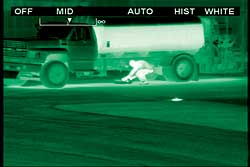
Hot Shots
Thermal technology takes its place in perimeter protection technology
 IN today’s troubled times, large industrial sites are in more danger of security breaches than ever before. With miles of perimeter fencing and multiple entrances to secure, large petrochemical plants are a complex security challenge. To guard against terrorists or other groups with the intent of violence, the sites are beginning to feature thermal imaging—a technology previously considered only accessible to the military—to help tighten security.
IN today’s troubled times, large industrial sites are in more danger of security breaches than ever before. With miles of perimeter fencing and multiple entrances to secure, large petrochemical plants are a complex security challenge. To guard against terrorists or other groups with the intent of violence, the sites are beginning to feature thermal imaging—a technology previously considered only accessible to the military—to help tighten security.
Everything emits thermal energy—even ice cubes—night and day, in good and bad weather. People can’t hide their body heat, and facilities can’t mask their thermal energy. Thermal images allow users to see things from farther away and with greater contrast than conventional visible-light cameras used in security networks worldwide. Thermal images don’t require external lighting, can’t be fooled by camouflage and can see man-sized targets from farther away than comparable TV cameras.
“Thermal imaging works when other technologies don’t,” said Andy Teich, president of FLIR Systems’ Commercial Vision Systems division. “Thermal imaging is ideally suited to security applications because it requires no lighting and provides superior threat detection day or night. Since it sees at night, through smoke and light fog, thermal imaging is the only technology that provides true 24/7 capability.”
Thanks to recent technological innovations and the increased production of thermal imagers, the technology’s price is becoming more affordable and available to security professionals.
“The ability to design and manufacture detectors, lenses and camera core assemblies, coupled with an expertise in military-qualified products, provides an opportunity to offer military hardened products at volume commercial prices,” Teich said.
Driving Technology
In 2005, FLIR Systems began creating high volumes of infrared detectors—the heart of its thermal imager, and the key to BMW’s Night Vision System nighttime driving aid. The detectors, which are available in 5, 6 and 7 series BMWs, allow the driver to see obstructions and hazards five times farther down the road than normal high beam headlights—giving the driver an increased reaction time.
The same imager has been leveraged as the PathFindIR and is the basis of an entire line of imagers for the security market. Now, thousands of imagers are produced every month and are deployed in commercial facilities, watching over border crossings and flying in unmanned air vehicles over Iraq and Afghanistan.
The evolution benefits today’s security professional. By revolutionizing high-volume, mass production of thermal imaging technology, thermal imagers are available at prices not imagined three years ago. Also, because the product development and productions processes are fully mature, recent efforts now focus towards customizing the imagers for the requirements of the security market itself, not just developing the basic technology.
Seeing Savings
The SR-19 is an example of how the hardware has been leveraged into a commercial application through innovation and mass production. An uncooled infrared sensor, the SR-19’s wide field of view provides excellent situational awareness, and its composite video output makes it easy to integrate into existing camera networks. The SR-19 includes advanced image processing software is designed to deliver high-quality image contrast regardless of scene dynamics.
“The SR-19’s 19-millimeter thermal imager provides excellent situational awareness and can detect a man-sized threat at more than 400 meters,” Teich said.
For those creating camera networks from the ground up, software packages are available for a range of applications. For people wanting to write their own software interfaces, a developer’s package is available. For those a little less adventurous, the Nexus graphical user interface provides a user front-end that allows everything from control of individual cameras to full networking and automated scan-and-alert capability.
“Systems are modular so that the integrator can choose content and value-added starts and stops. Thermal imaging offers a high-value solution to difficult problems. A savvy integrator can use these capabilities to differentiate their offering from other less-sophisticated competitors,” Teich said.
Perimeter Protection
Daunted by the sheer size, petrochemical plants can boast a perimeter of 10 miles or more. Added to this, much of the perimeter can cover areas—waterfront or wetlands—that don’t permit the use of the hardware typically thought of as part of a perimeter installation: a fence or fixed lighting. In a situation like this, thermal imaging is the only solution that makes sense economically, technologically and tactically.
“When compared to the economics of installing lighting towers in these areas, adding multiple thermal imagers with overlapping fields of view can garner up to three times the savings,” said Ryan Loughin, director of global sales for Security Services & Technologies. “While thermal imaging may seem to be a new, exotic technology, the imagers output a standard video signal, making them easy to integrate with existing CCTV networks. The nature of thermal imaging systems to be effective 24/7 allows security personnel to use motion-recognition software to effectively secure these fenceless areas without having to respond to false-positive alarms.”
A large petrochemical plant in the United States recently installed a number of thermal imaging systems alongside existing CCTV network, and officials have realized the benefits. Thermal imaging is a proven, affordable, available technology that is changing the way perimeters are secured.
About the Author
David Lee is a freelance writer based in Oregon.